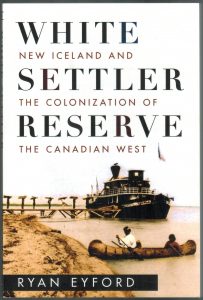Parliament for 90 years enforced a White Canada immigration policy intended to create an all-Caucasian society, literally a Great White North. It was built on crude and false assumptions of racial characteristics. Lawmakers and educators rarely speak of it today though the painful topic has inspired excellent academic research like White Settler Reserve, an exposé of attempts to create a Nordic master race on the Prairies.
It was a “special experiment of immigrant colonization”, newspapermen wrote in 1875. Cabinet subsidized Icelandic immigrants to colonize the southwest shore of Lake Winnipeg on territorial lands of the Cree, Ojibwe and Métis. Among the 19th century settlers were the great-great-grandparents of Prof. Ryan Eyford of the University of Winnipeg, who chronicles the experiment in a crisp narrative.
“Contemporary European racial theories posited that Icelanders should be part of the dominant race,” writes Eyford. “Canadian elites typically believed that ‘northern peoples’ were ideally suited to become colonists and future citizens, and thus the Icelanders were recruited and settled in the Northwest.”
Some 285 Icelanders were the first to arrive in 1875. Governor General Lord Dufferin called them “the grand old Norse race”; “They very much resemble the Norwegians,” wrote Dufferin. “They are quiet peaceable folk, Lutheran in religion, but not fanatical.”
White Settler Reserve explains, “Iceland was a source of endless fascination to European Romanticism because of its presumed isolation from world history. Philologists claimed that the Icelandic language was the ancient Norse tongue, once common to all Scandinavia, and ethnologists argued that Icelandic people were a racial anachronism, a strand of the ancient northern race preserved on an isolated northern isle.”
The campaign worked nicely in depopulating Iceland. Between 1870 and 1914 the island lost about a quarter of its population, about 20,000 men, women and children. The majority of immigrants came to Canada.
Icelanders were offered discounted steamship tickets and 160 acres free of charge under the 1872 Dominion Lands Act providing they busted sod and grew crops. They built communities named New Iceland and Gimli and Voger, Manitoba.
They also suffered from scurvy and smallpox, fire and flood, and the snide remarks of government agents who concluded they were not the Viking supermen Ottawa was looking for. The chief medical officer in Gimli described settlers as weak and lazy, “listless”, “dejected” and “apathetic”. “Centuries of isolation and intermarriage have had the effect of reducing their physical condition to a point below which they are likely to be successful,” wrote the Gimli doctor.
White Settler Reserve exposes one of those corners of Canadiana omitted from official records and federal observances. It is shocking and intriguing, the best kind of history.
By Holly Doan
White Settler Reserve: New Iceland and the Colonization of the Canadian West, by Ryan Eyford; University of British Columbia Press; 272 pages; ISBN 9780-7748-31598; $32.95






